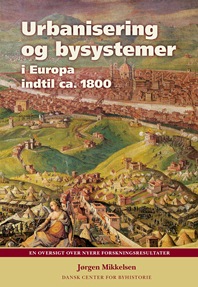Urbanisation and Urban Systems in Europe until ca. 1800
Urbanisering og bysystemer i Europa indtil ca. 1800 (Urbanization and Urban Systems in Europe until ca. 1800) explores the Nordic urban development between the Viking Ages and industrialization from a European perspective.
Before the industrialization in the 1700s and 1800s, the vast majority of cities in Europe had less than 5.000 inhabitants, and in almost all states more than ¾ of the population lived in the countryside. But the cities were political and administrative centers and junctions for the exchange of goods and culture. Despite their modest population, the cities played a significantly greater role than one might think.
Trade with the hinterland was the most important role for a very large part of the cities, but many places also had a particular function e.g. harbour, mining or fortress.
Urbanisering og bysystemer i Europa indtil ca. 1800 contains descriptions of:
- different types of cities and explores what it means to be a city
- 5 important stages in the history of the European urbanization
- the importance of state power for urban development in different states
- the role of trade in the the economic cycle
- models for economic interaction between cities - and how these models have been used
- differences and similarities between urban development in selected parts of Europe - including Denmark, Norway, Sweden and Finland, which have developed very differently.
The book summarizes a large number of research results from the last 30-40 years and can therefore be regarded as a general introduction to recent urban history in Europe.
Facts
Urbanisering og bysystemer i Europa indtil ca. 1800 (Urbanisation and Urban Systems in Europe until ca. 1800)
Skrifter om dansk byhistorie 11 (Writings on Danish Urban History 11)
Written by Jørgen Mikkelsen
Danish Centre for Urban History, 2012
293 p., ill.
ISBN 978-87-89328-65-2
